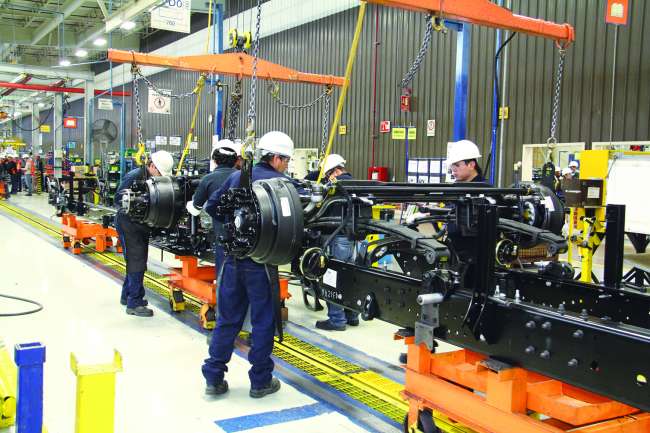Senior Reporter
Class 8 Orders Steamroll Year-Over-Year, Up 81% to Surpass 18,000

North American Class 8 orders blasted through normal expectations in July, climbing 81% year-over-year in what is typically the slowest order month of the year, analysts said.
Orders hit 18,700, according to preliminary data from ACT Research Co. The data will be updated as necessary later in the month.
A year earlier, orders only reached 10,358, ACT said, noting that July 2016 recorded the weakest monthly order intake since February 2010.
“The year-over-year story is not so much about what happened this year as it is about what didn’t happen last year,” ACT Vice President Steve Tam told Transport Topics.
July 2016 also was the bottom of the cycle in this market, he said.
“Since then, you can chalk [the gains] up to pre- and post-election sentiment,” Tam said. But as far as the industry having a consensus of where the market is right now, he’s not sure. “I think there is quite a bit of opacity, given the lack of concrete drivers, basically. And I think that is true even among the truck makers.”
July’s Class 8 North American preliminary net orders of 18,700 equates to a seasonally adjusted annual rate of 263,700; replacement for the same market is 225,000, Tam said.
The research firm FTR pegged preliminary Class 8 orders at 18,300.
“This is a great sign to see orders rising, even slightly [month-over-month, up from 17,600 in June], in mid-summer. This is the beginning of a positive trend that we expect to continue the rest of this year, right into 2018. The Class 8 market is starting to move upward and orders are forecasted to accelerate in the fall,” Don Ake, Vice President of Commercial Vehicles at FTR, commented in a statement.
“Freight is on the upswing and industry capacity is tightening,” he said.
Orders for the past 12 months total 224,000 units, according to FTR.
As with the several previous months, “the strength was largely broad-based across [truck makers] with orders being propelled by small and medium fleets and it appears that some incentivization is taking place in the marketplace,” analyst Jamie Cook of Credit Suisse wrote in a note to investors.
Tam mentioned the experience of the owner of a 200-truck fleet in Indiana who told him she is being offered big-fleet pricing discounts and couldn’t walk away from such a good deal, even if it was ahead of her normal trade cycle.
“The concern from an outside industry observer’s perspective,” Tam said, “is that if you are pulling forward demand, at what point do you have to start paying back?”
He wondered if the Indiana fleet made a permanent change to its acquisition cycle, or if it did not get the same discounts next time, would it hold off?
“Now you are stretched out on the back end,” Tam said.
One truck maker said incentives are the rule.
“Every single deal is competitive. Every truck maker is on every deal, it appears,” Jeff Sass, Senior Vice President, North America Truck Sales and Marketing at Navistar International Corp., told TT. “It’s not as if anyone has decided they are going to go off and make a lot of margin on the trucks. They are all really skinny deals out there.”
Navistar is the parent company of the International Truck brand.
Lead times at International are out to eight weeks, Sass said, and its dealers are trying to make sure they get their orders submitted in time to get into the fiscal year, which for Navistar ends Oct. 31, since a lot of them follow the same fiscal calendar.
At the same time, most of the mega fleets are done for 2017, Sass said. “Their trucks are on order, or have already been placed. We are starting the conversation for the 2018 buys right now.”
Another analyst noted orders will be increasingly important going forward to fill up still-open production slots this year.
Based on truck makers’ build plans in July to produce 22,000 units — or a 270,000 annual build rate — “that would imply backlog-to-build levels of 4.4 months, reaching a three-year low and suggesting that monthly orders will be increasingly important in determining quarterly production beyond the third quarter, particularly given the fourth quarter schedule is 61% open as of last month, versus normal of 54%,” David Leiker an analyst with Robert W. Baird & Co., wrote in a note to investors Aug. 3.
Tam agreed, saying all truck makers were likely already into the fourth quarter with their respective production schedules, “but to varying degrees.”

